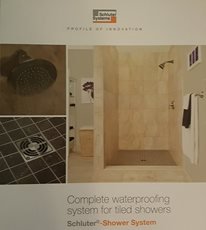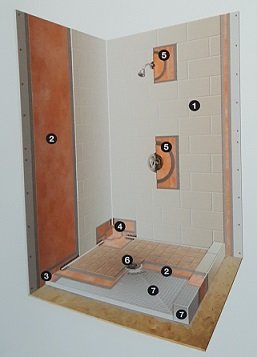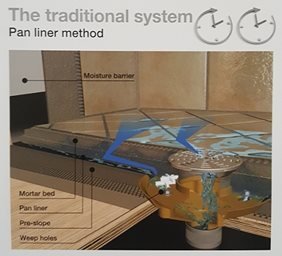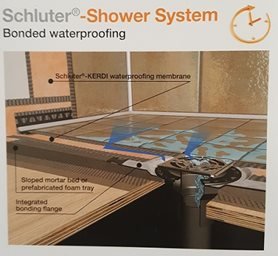
Where Does All The Water Go?
Have you ever wondered where all of the water from your shower goes? Sure, we know some goes down the drain, but did you know water also soaks into your tile and grout? Where does that water go? It is a common misconception that tile and grout are water proof, and many people don’t actually understand how water in showers or tub surrounds gets out. An improper installation, or just age, can lead to damage and mold under the surface, which will eventually cause problems to the framing structure and lead to mold. So what can be done to avoid water problems in a shower or tub surround? Schluter Systems is a complete waterproofing system. We are certified installers and authorized dealers for Schluter products. Here are some important facts about traditional shower installations versus Schluter Systems:
About Schluter Systems:
Completely Waterproof – The Schluter KERDI membrane and KERDI-DRAIN provide the foundation to the waterproof and vapor tight system. Since it is waterproof, it does not allow for mold to grow or for rot to set in to framing. KERDI is a bonded membrane and allows for tile to be installed directly to it, protecting the base and walls from water and moister.

Durable – The KERDI membrane will not degrade over time. It is also resistant to chemicals that are commonly used for cleaning, that may soak into tile and grout.
Simple to Install – The Schluter System offers pre-formed shower trays, curbs, benches and niches, making it easier to build the components of a shower, saving time and labor hours during installation. Metal trims finish off raw edges and corners beautifully and KERDI-DRAIN offers several drain styles that work seamlessly with the system, even offering inline and tillable “invisable” drains.

How a Traditional Shower System Works:

1. A pre-slop is created, pitched towards the drain opening
2. A pan liner is placed over the pre-slope
3. A mortar bed is built up on top of the pan liner
4. A drain with weep holes is installed
5. Moister barrier is put on the walls and lapped over the shower pan
6. Tile is then installed over top of the mortar bed using thinset, then grouted
All of these steps are labor intensive and take time to set up between stages. When in use, the shower water goes down the drain…BUT NOT ALL OF IT. The water soaking in to the tile and grout also soaks through the mortar bed, and travels to the weep holes in the drain to escape. If the water does not make it to the weep holes because the slope is incorrect, or if the weep holes are clogged, the water does not escape, which sets the stage for framing and drywall damage, as well as mold growth and possible water damage to rooms below the shower.
The Schluter System Difference:

1. Pre formed shower tray is installed
2. KERDI-DRAIN is installed with bonding flange
3. KERDI-Membrane is installed over shower tray and walls
4. Tile is installed over membrane using thinset, then grouted
With less components and labor, this installation goes much quicker. When in use, water that does not go down the drain never goes any further than the waterproof membrane. It travels over the membrane directly to the drain, keeping all water and moister away from any framing or drywall, preventing moister build up and mold.
Schluter products can be seen in our showroom. Keep an eye out for our next Schluter product feature of Schluter DITRA-HEAT, for easy to install and customizable heated floors.

